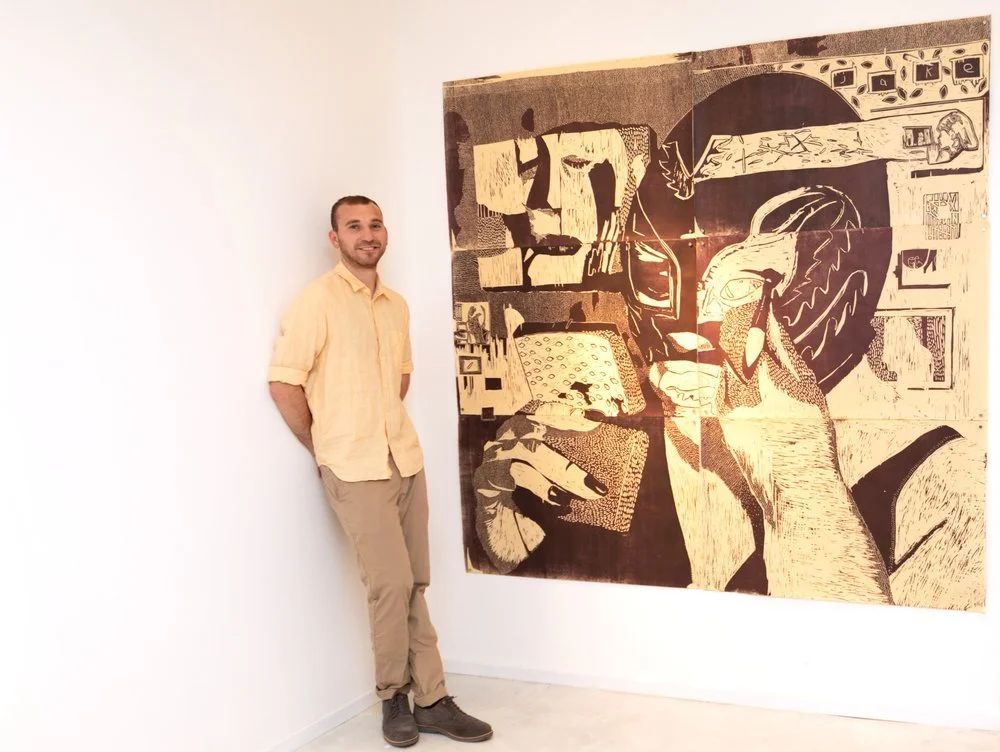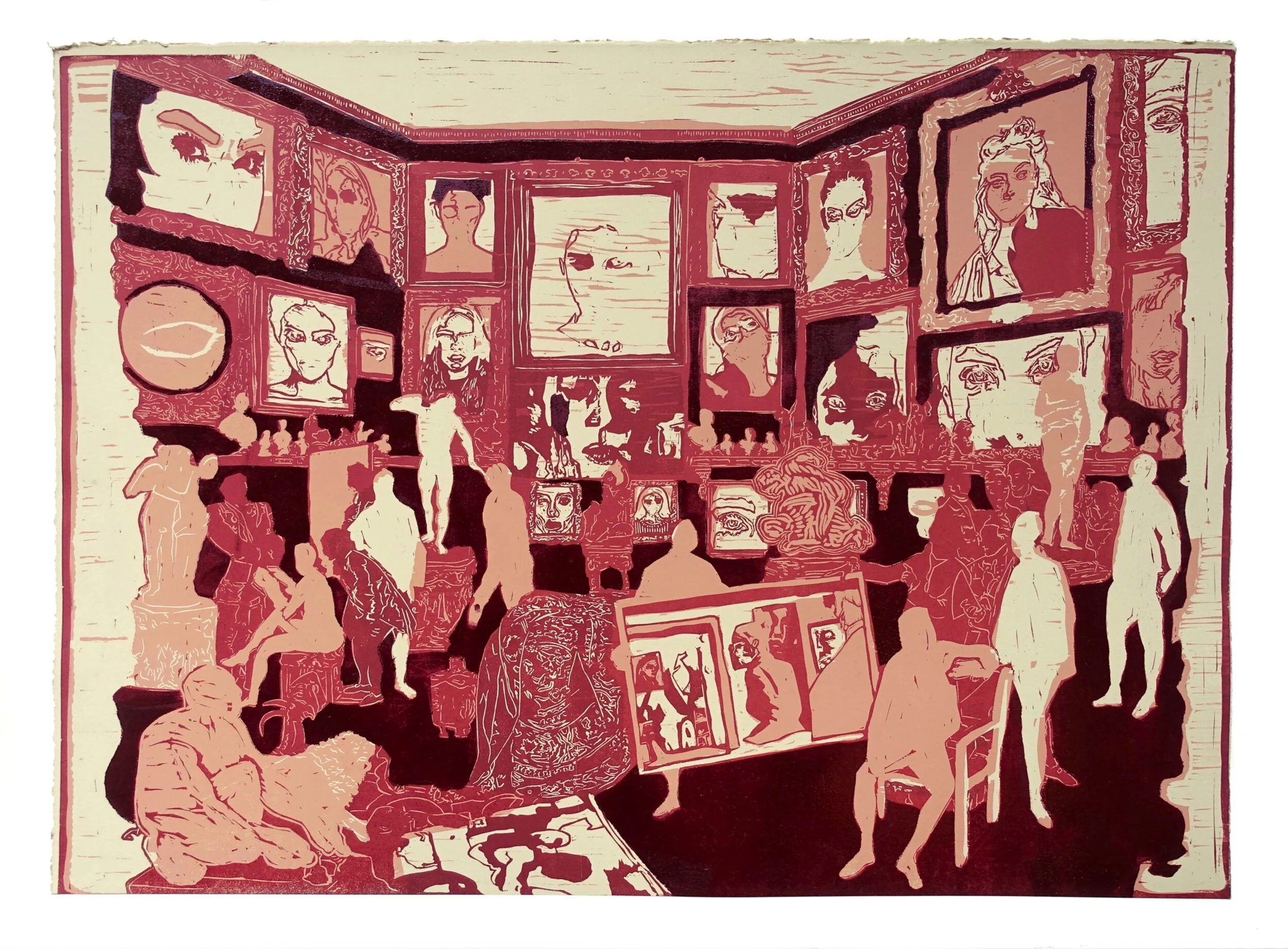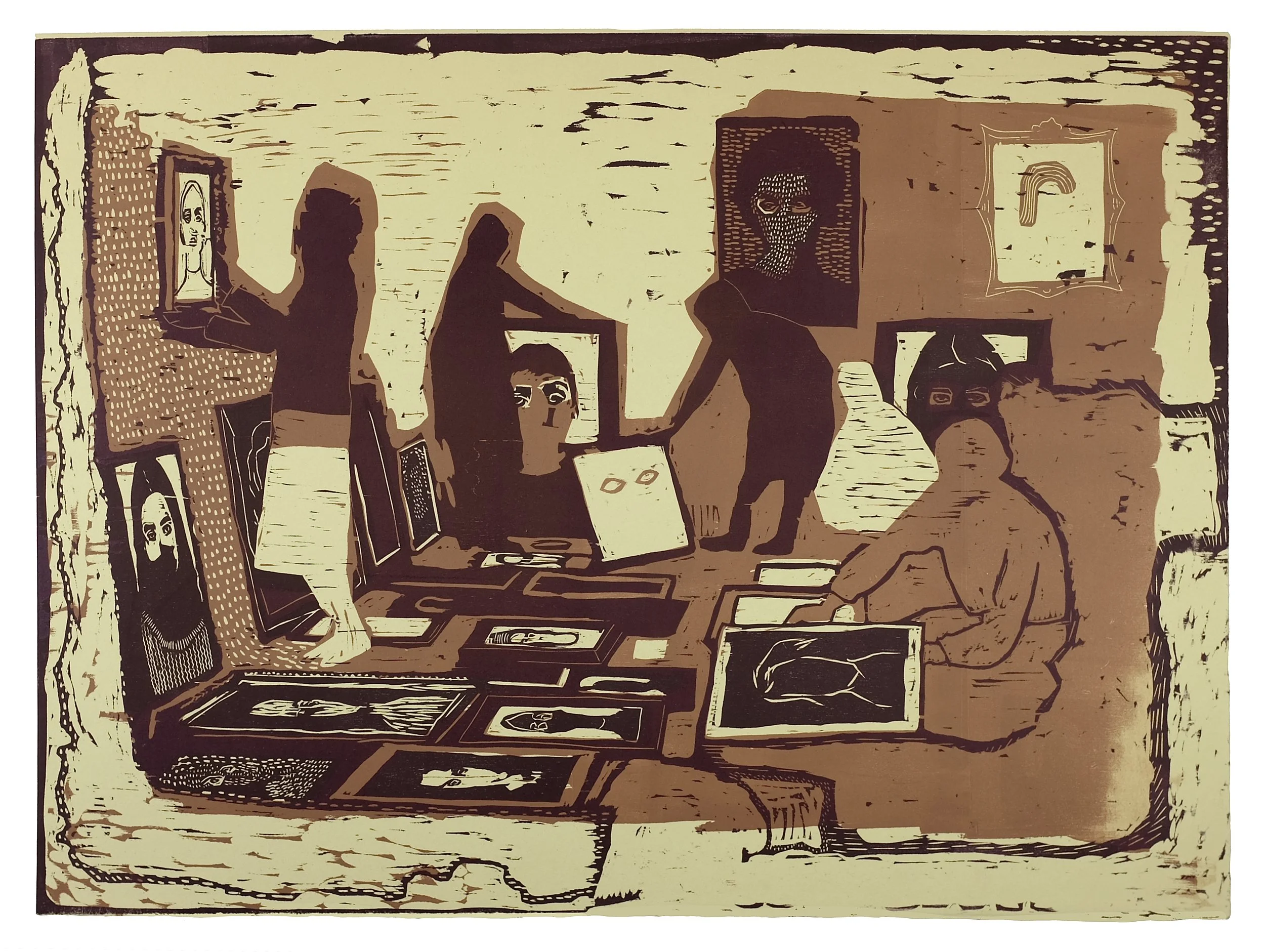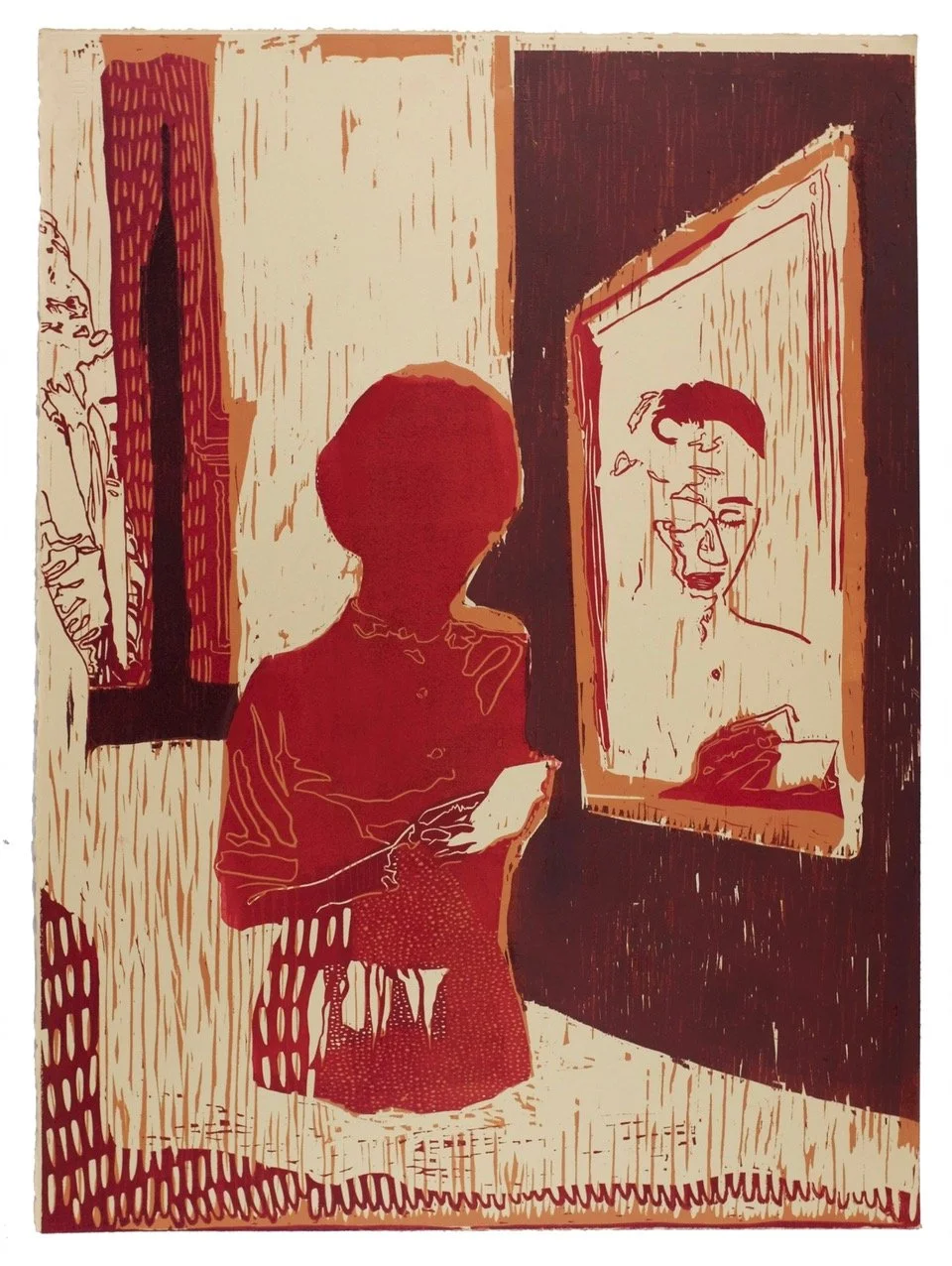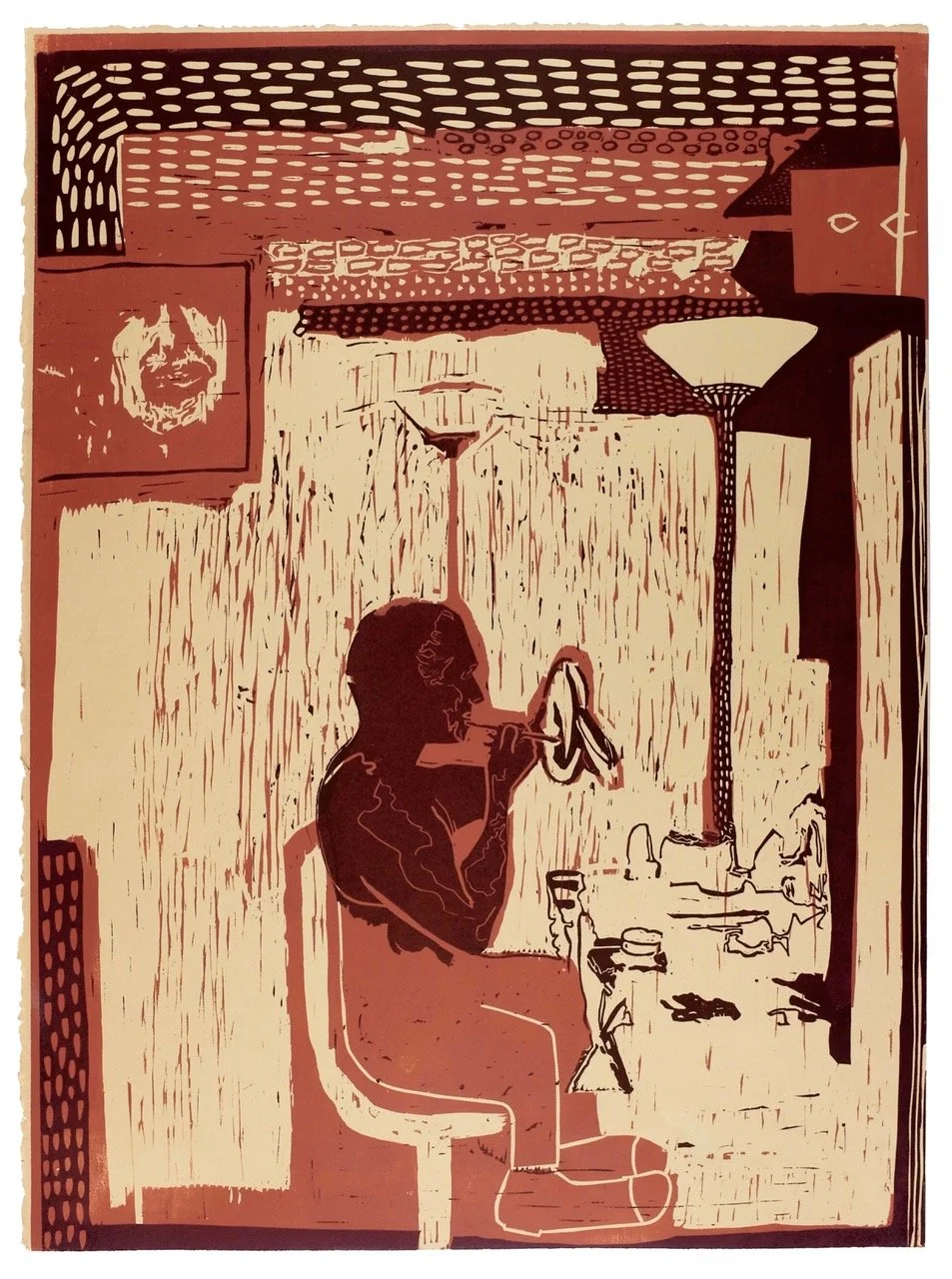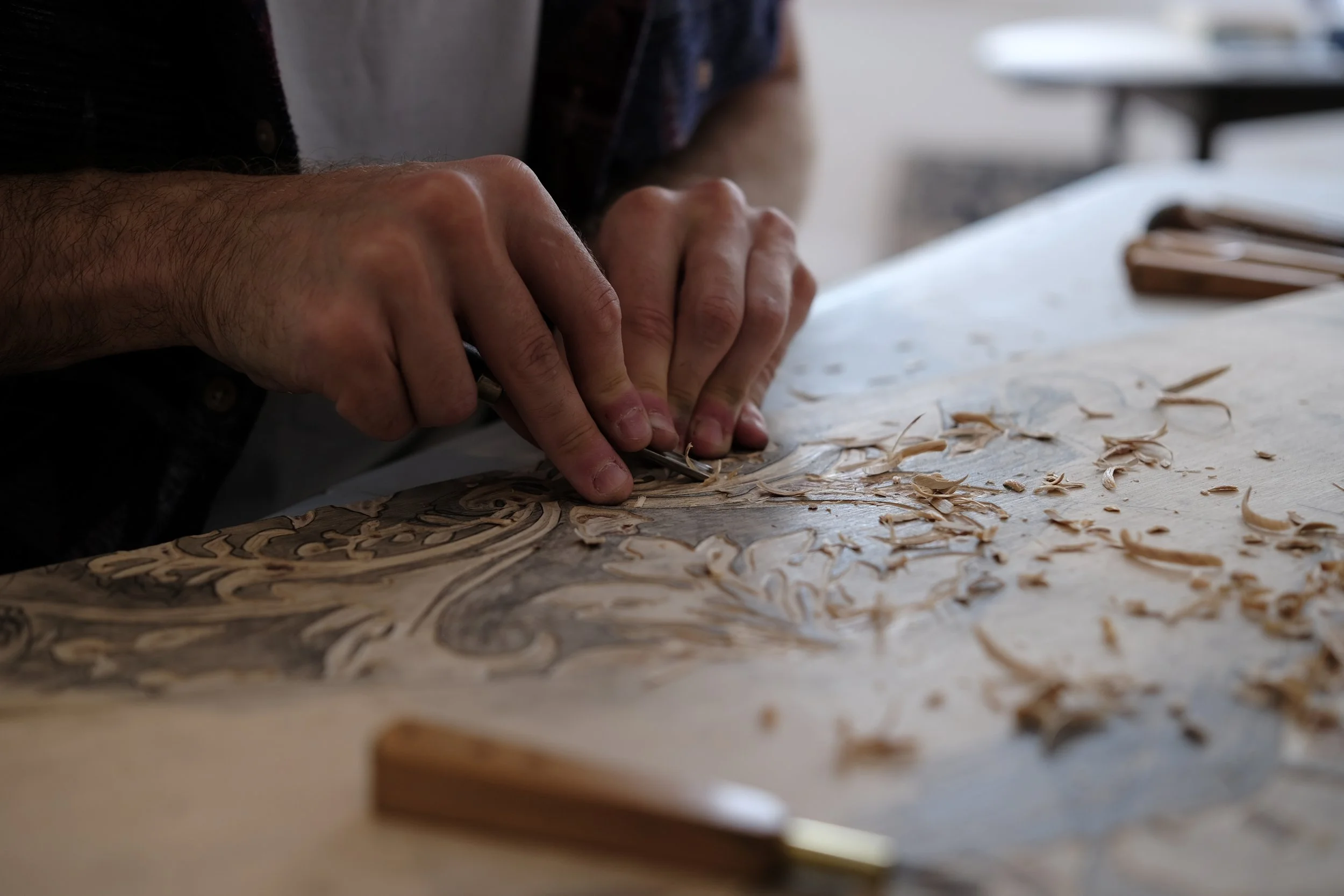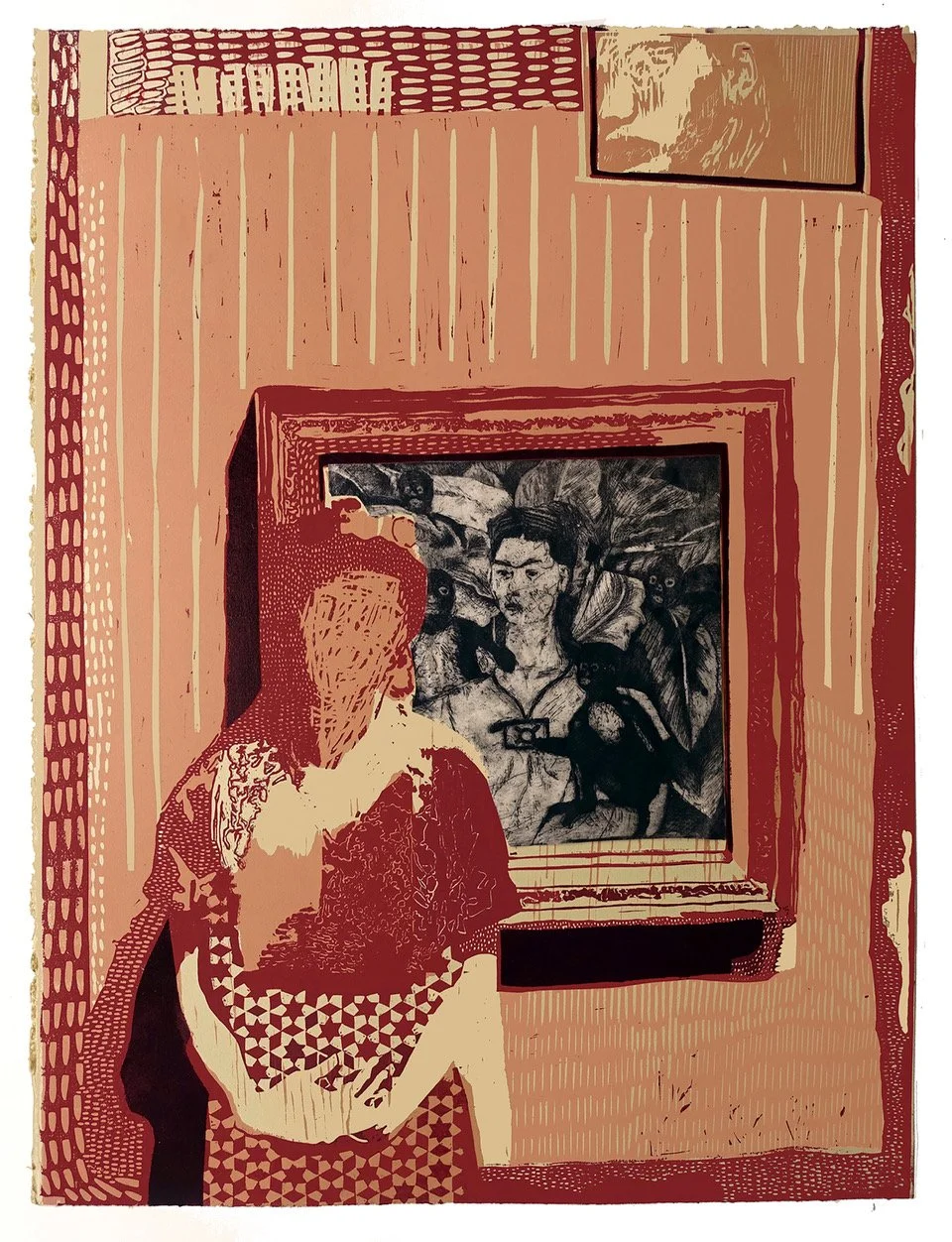Interview | Jake garfield
Jake Garfield is a London-based artist working primarily with printmaking. He was awarded the Boodle Hatfield Printmaking Prize 2021 at Woolwich Contemporary Print Fair. The artwork produced as part of the prize will be exhibited as a solo showcase at this year’s 2022 Fair.
Face-painting and pictures-within-pictures are recurring motifs in a series of multi-layered woodcuts exploring the notion of artistic persona. Jake’s printmaking blurs the distinction between the world of the artist, the world of an image and meta-worlds within an image. His unique practice is rooted in the Fair’s mantra to reinterpret traditional techniques for contemporary audiences and he has shown with WCPF for a number of years.
Jake’s work lives in public and private collections, including The Royal Collection and The British Museum.
We’re thrilled that you will be exhibiting with us again this year at Woolwich Contemporary Print Fair. Could you start by introducing yourself?
I’m an artist who works almost exclusively with printmaking and for the past three or four years my main focus has been with woodcut. My main interest is the relationship between pictures and reality, between artwork and the world we live in. One device that I use to explore this is ‘pictures-within-pictures’ within the artwork. For instance, there might be an etching embedded within a woodcut to represent a painting that’s on a wall. The etching, even though it's the fiction within that world, might feel more real than the figure because it can hold more detail. But because it’s black and white, it’s largely drained of emotional qualities. So a viewer might get the emotion from the colour in the woodcut part.
Often in my work, it’s the things on the edges - the wallpaper or background - that hold the most information. Whereas, the main subject, like a figure, has their face washed out or crudely carved away. These are strategies to create a sense of time in the artwork and to encourage people to spend more time looking around the whole fictional world, instead of just offering one focus.
PRIVATE VIEW, Woodcut, Lino and Stencil on BFK Rives paper, 280gsm, 76 x 56 cm, edition of 15
In 2021, you were awarded the Boodle Hatfield Printmaking Prize for your artwork ‘Private View’. Could you tell us more about this print and the inspiration behind it?
This piece is part of ‘The Emerging Artist and Other Favourites’ series. It’s based on a painting ‘The Tribuna of the Uffizi’ by Johan Zoffany. It’s really a piece about looking and the idea of the gaze. Usually pictures are objects to be looked at but in ‘Private View’, I wanted to give them the agency to do the looking. In my version, you have female faces staring out of their picture frames. While the men are confused and anonymous, like silhouettes and without identity. Therefore, it’s the pictures within the piece that have subjectivity. I have also placed emphasis on their eyes: these paintings look out at the figures in front of them but also beyond the wider picture frame towards the viewer. They remind us that we’re complicit in this scene.
WOMEN HANGING AN EXHIBITION, 2021, Woodcut on Tan BFK Rives paper, 280 gsm, 56 x 76 cm, edition of 5
the questions around the gaze, agency and power in your work are very interesting. This idea of framing in and around the artwork to form a direct relationship with the viewer, brings about the relationship to scale in your work. How do these questions evolve with scale and how does this push the possibilities of WOODCUT as a medium?
In ‘The Emerging Artist and Other Favourites’ series, I made the decision to make them all the same size. I wanted to create some cohesion between the works, and to make sure they all felt like they were part of the same series. I arrived at the scale through trial and error: I knew I had to make them big enough that each piece could contain a fair amount of information but small enough that i could work on multiple blocks at the same time.
The new project I’m working on will have works at a range of sizes, including one that is just under three metres across. Working on this scale introduces an extra challenge within the artwork and making process because it has to work when being viewed from a distance and when close up. You want something to have more detail, to create a feast for the eyes of the viewers but overall, the composition still has to work.
WOMAN READING A LETTER, 2021, Woodcut and Lino on Tan BFK Rives paper, 280 gsm, 76 x 56 cm, edition of 15
We were delighted to present your solo exhibition of work ‘Emerging Artist (And Other Favourites)’ at Mayfair Art Weekend in June 2022. A really exciting idea within this work is the ‘state of becoming’ and print as a citational practice through repetition, layering and masking of imagery and self, truth and fiction. How is this body of work that you have developed feeding into your current practice?
I’m always quoting and sampling in some way - everything is based on secondary source material. Sometimes it’s more of a cover version, like my piece ‘Velazquez Study’. Sometimes I will include my version of an artwork as a picture-within-a-picture. Sometimes I will take a photo, film still or an artwork and reference it as a starting point as I sketch out a new composition that borrows certain elements. You’re forced to be aware of the ways images are constantly reproduced and disseminated to create a fiction. Within the printmaking process, you often have to deconstruct an image before building it back together again. You have to break everything down into these pictorial elements, you can’t help but realise how constructed, contrived and fictionalised the image-making process is.
I’m also trying to understand my persona as an artist and the masks we wear in the world.
MAN APPLYING MAKE-UP IN CIRCULAR MIRROR, BOB DYLAN POSTER BEHIND, 2021, Woodcut and Lino on Tan BFK Rives paper, 280 gsm, 76 x 56 cm, edition of 5
As part of this prize, you’re showcasing new work at WCPF this November. Can you talk to us about this new print and the processes you’ve been using?
I’ll be showing four pieces at the Fair, which are all versions of the same idea. The pieces at the Fair are loosely based on a Jacob Epstein’s monumental sculpture ‘Jacob And The Angel’, which depicts the biblical story of Jacob wrestling an unknown assailant. I think of my piece as something fictional that is informed by the Epstein sculpture, rather than something illustrating the story from Genesis.
Epstein’s sculpture is massive and was carved out of alabaster, which in a sense it had to be because the story of Jacob wrestling the Angel is one of physical struggle and perseverance. The centre-piece of my showcase is this woodcut in nine panels, which is nearly three metres across. I’m hoping the scale helps to create meaning in the work, because the labour involved in carving the blocks is reflective of the subject matter.
The piece is called ‘Jake Wrestling An Angel’, but the Jake isn’t me. He’s a character. The pieces for Woolwich are the first I’ve made from this new series so I will learn more about him as the project develops. It’s something that has been bubbling away for years! The first ‘Jake The Boxer’ I did was in 2013 - nearly ten years ago, which referenced Jake LaMotta, or more specifically Robert De Niro playing Jake LaMotta in Raging Bull. I like the idea of projecting something of myself or having something that is an echo of myself. It may be that he becomes an outlet for me to explore ideas around masculinity. Where persona meets self and reality meets fiction.
Because of the labour-intensive nature of woodcut, there is this sense that you are excavating your own self through the medium. What draws you to woodcut as a method? Could you also expand on the relationship and tension between traditional and contemporary techniques and references?
The ways in which you can break an image down in printmaking was one of the reasons I was drawn to it. I like the way you can feel the alchemy in the process. Labour is also something that I’ve been thinking quite a lot about, particularly with this new piece because of its scale. The work depicts a struggle. For me, the labour of the process is relevant to the subject matter and meaning is created through the making. Through the wobbly lines and mistakes, there is something human about the struggle of me trying to make something this big.
I like the idea of using a time-honoured process to talk about contemporary concerns. There is something very direct about woodcut, you’re literally carving into the material and you can see exactly how that image is formed. It’s really intuitive and straightforward but at the same time, through layering and incorporating other processes you can bring in depth and illusion.
I also really like the flatness that comes with woodcut, it’s inherent in the medium and reminds you that you’re looking at a picture. In my work, there will often be wallpaper patterns or mark-making, like dots and dashes, that aren’t about depicting space but about surface. You never let go of the feeling of flatness and the medium is always so present in your final piece. You’re always grappling with the medium and in conversation with the process.
MAN WRESTLING AN ANGEL, 2022, woodcut in nine panels on 280gsm paper, 288 x 228cm, edition of 6
And finally, who are your artistic inspirations? How have they influenced the ways you approach your own work?
The writer Charlie Kaufman is a big influence. I like the way his films and novel are so self-reflexive, and manage to be so sincere and absurd at the same time. I think Diego Velasquez is amazing, I take a lot from the way he uses pictures-within-pictures and inserts little hints of himself in the work.
In terms of artists working in woodcut, Tom Hammick was the person who introduced me to printmaking. The kind of virtuosity he has with the medium, the way that images emerge through a mastery of process - they’re such ambitious works! Also Christiane Baumgartner, polar opposite to Tom Hammick. Her woodcuts are also hand-carved but in a disciplined and methodical way. They say so much about the we value images, and our relationship to time and technology.
WOMAN DRESSED AS FRIDA IN FRONT OF FRIDA KAHLO SELF-PORTRAIT, 2020, Woodcut, Lino, Stencil, Etching With Aquatint & Chine Collé on BFK Rives paper, 280gsm, 56 x 76 cm, edition of 15
You can discover more of Jake Garfield’s artwork at Woolwich Contemporary Print Fair, here.
Find more Printmaking Inspiration here.
Woolwich Contemporary Print Fair, 03 - 06 November 2022. Details here.
Thanks to our partner Boodle Hatfield LLP.

